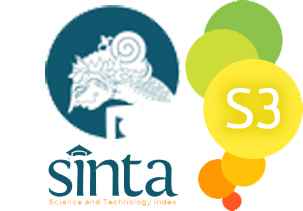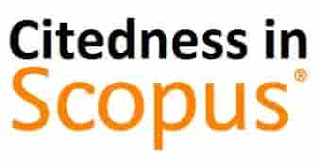Detection of Diarrhoegenic E. coli on Diarrhea Feces Samples at Batulicin and Pagatan Communities Health Centre, Tanah Bumbu District with Polymerase Chain Reaction (PCR) Method
Abstract
Diarrhoegenic E. coli (DEC) is a group of pathogenic E. coli strains known to be one of the causes of diarrheal disease. Diarrhea cases are still quite high in developing countries like Indonesia. Tanah Bumbu Regency, especially Batulicin and Pagatan, have a fluctuating rate of diarrhea. This study aims to detect DEC in diarrheal patients in the work area of Batulicin and Pagatan Health Centers using the PCR examination method. Cross Sectional research design with a total sample of 15 respondents collected for 3 months (August - October 2019). Stool samples were examined using the PCR method to detect the presence of DEC strains namely EAEC, ETEC, and EPEC and EHEC. Three out of fifteen (20%) samples were known to be positive for Diarrhoegenic E. coli (DEC). ETEC strains were found in 2 (0,13%) sample, each from the Batulicin Health Center and the Pagatan Health Center, while EPEC and EAEC strains were found in the same 1 (0,07%) sample from the Pagatan Health Center. EHEC strain was not detected in all samples. Diarrhogenic E. coli strains found in this study are EAEC, ETEC, and EPEC. However, it cannot be ascertained yet that the three strains are the cause of the diarrheal disease, it needs to be further to do comprehensive research. The community should be able to increase awareness of the importance of clean and healthy behavior, especially food and beverages consumption, so it can reduce the number of diarrhea cases.
References
Acosta, G. J., Vigo, N. I., Durand, D., Riveros, M., Arango, S., Zambruni, M., & Ochoa, T. J. (2016). Diarrheagenic Escherichia coli : Prevalence and pathotype distribution in children from Peruvian rural communities. Am J Trop Med Hyg, 95(3), 574–579. https://doi.org/10.4269/ajtmh.16-0220
Al-shuwaikh, A. M., Ibrahim, I. A. J., & Shwaikh, R. M. A.-. (2015). Detection of E . coli and Rotavirus in Diarrhea among Children Under Five Years Old. Iraqi Journal of Biotechnology, 14(August), 85–92. Retrieved from ttps://www.researchgate.net/publication/280741224
Ali, M. M. M., Mohamed, Z. K., Klena, J. D., Ahmed, S. F., Moussa, T. A. A., & Ghenghesh, K. S. (2012). Molecular characterization of Diarrheagenic Escherichia coli from Libya. American Journal of Tropical Medicine and Hygiene, 86(5), 866–871. https://doi.org/10.4269/ajtmh.2012.11-0330
Andiarsa, D., Setyaningtyas, D. ., Hidayat, S., Setianingsih, I., Hamsyah, & Hariyati, E. (2018). Spatial effect of refilling drinking water depots toward diarrhea in Pagatan, Subdistrict of Kusan Hilir, Tanah Bumbu District, Sounth Kalimantan. The 4th International Conference on Public Health, 4, 40–48. https://doi.org/10.17501/24246735.2018.4105
Azaria, C., & Rayhana. (2016). Hubungan penerapan perilaku hidup bersih dan sehat ( PHBS) ibu dengan kejadian diare balita di wilayah kerja Puskesmas Kacang Pedang 2015. Kedokteran Dan Kesehatan, 12(1). Retrieved from https://jurnal.umj.ac.id/index.php/JKK/article/view/1551
Black, R. E., Morris, S. S., & Bryce, J. (2003). Where and why are 10 million children dying every year? Lancet, 361(9376), 2226–2234. https://doi.org/10.1016/S0140-6736(03)13779-8
Bonkoungou, I. J. O., Haukka, K., Österblad, M., Hakanen, A. J., Traoré, A. S., Barro, N., & Siitonen, A. (2013). Bacterial and viral etiology of childhood diarrhea in Ouagadougou , Burkina Faso. BioMed Central, 13(36), 2–7. Retrieved from http://www.biomedcentral.com/1471-2431/13/36
Breurec, S., Vanel, N., Bata, P., Farra, A., Nguyen, B. L., Onambélé, M., Rafa, C., & Razakandrainibe, R. (2016). Etiology and Epidemiology of Diarrhea in Hospitalized Children from Low Income Country : A Matched Case-Control Study in Central African Republic. (December 2011), 1–18. https://doi.org/10.1371/journal.pntd.0004283
Clements, A., Young, J. C., Constantinou, N., & Frankel, G. (2012). Infection strategies of enteric pathogenic Escherichia coli. Gut Microbes, 3(2), 71–87. https://doi.org/10.4161/gmic.19182
Corrales, C. P., & Sandí, K. L. (2019). Diarrheagenic Escherichia coli in Costa Rican children : a 9 ‑ year retrospective study. BMC Research Notes, (December 2016), 1–6. https://doi.org/10.1186/s13104-019-4313-1
Diniz, L. M. O., & Figueiredo, B. de C. G. e. (2014). The newborn’s immune system. Revista Médica de Minas Gerais, 24(2), 227–233. https://doi.org/10.5935/2238-3182.20140056
Diouf, K., Tabatabai, P., Rudolph, J., & Marx, M. (2014). Diarrhoea prevalence in children under five years of age in rural Burundi: An assessment of social and behavioural factors at the household level. Global Health Action, 7(1), 1–9. https://doi.org/10.3402/gha.v7.24895
Dutta, S., Guin, S., Ghosh, S., Pazhani, G. P., Rajendran, K., Bhattacharya, M. K., Takeda, Y., Nair, G. B., & Ramamurthy, T. (2013). Trends in the prevalence of Diarrheagenic Escherichia coli among hospitalized diarrheal patients in Kolkata, India. PLoS ONE, 8(2). https://doi.org/10.1371/journal.pone.0056068
Gorback, S. L. (1996). Medical Microbiology 4th edition (Fourth; Galveston, Ed.). Retrieved from https://www.ncbi.nlm.nih.gov/books/NBK7670/
Gunzburg, S. T., Tornieporth, N. G., & Riley, L. E. E. W. (1995). Identification of Enteropathogenic Escherichia coli by PCR-Based Detection of the Bundle-Forming Pilus Gene. Journal of Clinical Microbiology, 33(5), 1375–1377. Retrieved from https://www.ncbi.nlm.nih.gov/pubmed/7615759
Gupta, A. (2014). Study of the prevalence of Diarrhoea in children under the age of five years: it’s association with wasting. Indian Journal Sciences Research, 7(1), 1315–1318. Retrieved from http://citeseerx.ist.psu.edu/messages/downloadsexceeded.html
Gurpreet, K., Tee, G. H., Amal, N. M., Paramesarvathy, R., & Karuthan, C. (2011). Incidence and determinants of acute diarrhoea in Malaysia: a population-based study. Journal of Health, Population, and Nutrition, 29(2), 103–112. Retrieved from http://www.ncbi.nlm.nih.gov/pubmed/21608419%0Ahttp://www.pubmedcentral.nih.gov/articlerender.fcgi?artid=PMC3126982
Hairani, B., & Andiarsa, D. (2017). Hubungan pengetahuan ibu dan perilaku memasak air minum dengan kejadian diare balita di Puskesmas Baringin Kabupaten Tapin tahun 2014. 3(1), 10–14. https://doi.org/10.22435/jhecds.v3il.5655
Hudault, S., Guignot, J., & Servin, A. L. (2001). Escherichia coli strains colonising the gastrointestinal tract protect germfree mice against Salmonella typhimurium infection. Gut, 49(1), 47–55. https://doi.org/10.1136/gut.49.1.47
Iijima, Y., Oundo, J. O., Hibino, T., Saidi, S. M., Hinenoya, A., Osawa, K., Shirakawa, T., Osawa, R., & Yamasaki, S. (2017). High prevalence of diarrheagenic Escherichia coli among children with diarrhea in Kenya. Japanese Journal of Infectious Diseases, 70(1), 80–83. https://doi.org/10.7883/yoken.JJID.2016.064
Institute for Health Metrics and evaluation. (2017). Global Burden of Diseases. Retrieved from http://www.healthdata.org/indonesia
Irianty, H., Hayati, R., & Riza, Y. (2018). Hubungan Perilaku Hidup Bersih dan Sehat (PHBS) dengan kejadian diare pada balita. PROMOTIF: Jurnal Kesehatan Masyarakat, 8(1), 1. https://doi.org/10.31934/promotif.v8i1.224
Kabiru, L. M., Bello, M., Kabir, J., Grande, L., & Morabito, S. (2015). Detection of pathogenic Escherichia coli in samples collected at an abattoir in Zaria, Nigeria and at different points in the surrounding environment. International Journal of Environmental Research and Public Health, 12(1), 679–691. https://doi.org/10.3390/ijerph120100679
Krogfelt, K. A., Cohen, P. S., & Conway, T. (2004). The Life of Commensal Escherichia coli in the Mammalian Intestine. EcoSal Plus, 1(1). https://doi.org/10.1128/ecosalplus.8.3.1.2
Kusuma, E. A., Rasyid, R., & Endrinaldi. (2015). Identifikasi bakteri coliform pada air kobokan di rumah makan Kelurahan Andalas Kecamatan Padang Timur. Jurnal Kesehatan Andalas, 4(3), 845–849. Retrieved from http://jurnal.fk.unand.ac.id/index.php/jka/article/view/374
Menteri Kesehatan RI. (2011). Peraturan Menteri Kesehatan No.2406 Tahun 2011 tentang Pedoman Umum Penggunaan Antibiotik. Peraturan Menteri Kesehatan No. 2406 TAHUN 2011 Tentang Pedoman Umum Penggunaan Antibiotik, 4. https://doi.org/10.1017/CBO9781107415324.004
Nada, RA. Shaheen, HI. Touni , I., Fahmy, D., Armstrong, AW., Weiner, M., Klena, J. (2010). Design and validation of a multiplex polymerase chain reaction for the identification of Enterotoxigenic Escherichia coli and associated colonization factor antigens. Diagnostic Microbiology and Infectious Disease, 67(2), 134–142. https://doi.org/10.1016/j.diagnicrobio.2010.01.011
Osawa, K., Raharjo, D., Wasito, E. B., Harijono, S., Shigemura, K., Osawa, R., Sudarmo, S. M., Iijima, Y., & Shirakawa, T. (2013). Frequency of diarrheagenic Escherichia coli among children in Surabaya, Indonesia. Japanese Journal of Infectious Diseases, 66(5), 446–448. https://doi.org/10.7883/yoken.66.446
Pouladfar, G., Arasteh-Far, A., Amin-Shahidi, M., Firoozian, N., Pourabbas, B., Moghadami, M., & Fani, F. (2017). Characterization of Diarrheagenic E. coli causing a diarrheal outbreak in the south of Iran, Summer 2015. Asian Pacific Journal of Tropical Disease, 7(8), 491–495. https://doi.org/10.12980/apjtd.7.2017d7-94
Praveen, P., Jordan, F., Priami, C., & Morine, M. J. (2015). The role of breast-feeding in infant immune system: a systems perspective on the intestinal microbiome. Microbiome, 3(May 2016), 41. https://doi.org/10.1186/s40168-015-0104-7
Rahmadhani, E. P., Lubis, G., & Edison. (2013). Hubungan pemberian ASI eksklusif dengan angka kejadian diare akut pada bayi usia 0-1 tahun di Puskesmas Kuranji, Kota Padang. Jurnal Kesehatan …, 2(2), 62–66. Retrieved from http://jurnal.fk.unand.ac.id/index.php/jka/article/view/121
Ramakrishna, B. S. (2007). The normal bacterial flora of the human intestine and its regulation. Journal of Clinical Gastroenterology, 41(SUPPL. 1), 2–6. https://doi.org/10.1097/MCG.0b013e31802fba68
Redaksi, T. (2017a). Data Profil Puskesmas Pagatan 2017. Pagatan, Tanah Bumbu, Kalimantan Selatan.
Redaksi, T. (2017b). Profil Puskesmas Batulicin Tahun 2017. Batulicin, Tanah Bumbu, Kalimantan Selatan.
Sari, D. M. (2016). Hubungan sumber air minum terhadap kejadian diare pada keluarga. TRIK: Tunas-Tunas Riset Kesehatan, VI(4), 194–198. Retrieved from http://2trik.jurnalelektronik.com/index.php/2trik/article/view/30
Schmidt, H., Knop, C., Franke, S., Aleksic, S., Heesemann, R., & Karch, H. (1995). Development of PCR for screening of Enteroaggregative Escherichia coli. Journal Clinical of Microbiology, 33(3), 701–705. Retrieved from https://www.ncbi.nlm.nih.gov/pubmed/7751380
Selviana, S., Trisnawati, E., & Munawarah, S. (2017). Faktor-faktor yang berhubungan dengan kejadian diare pada anak usia 4-6 tahun. Jurnal Vokasi Kesehatan, 3(1), 28. https://doi.org/10.30602/jvk.v3i1.78
Spano, L. C., Sadovsky, A. D. I., Segui, P. N., Saick, K. W., Kitagawa, S. M. S., Pereira, F. E. L., Fagundes-neto, U., & Scaletsky, I. C. A. (2017). Age-specific prevalence of diffusely adherent Escherichia coli in Brazilian children with acute diarrhoea. (2008), 359–363. https://doi.org/10.1099/jmm.0.47660-0
Sujaya, N., Aryantini, N. P. ., Nursini, N. ., Purnama, S. ., Dwipayanti, N. M. ., Artawan, I. ., & Sutarga, I. . (2010). Identifikasi penyebab diare di Kabupaten Karangasem , Bali. KESMAS: National Public Health Journal, 4(4), 186–191. Retrieved from http://journal.fkm.ui.ac.id/index.php/kesmas/article/view/180
Taniuchi, M., Sobuz, S. U., Begum, S., Platts-mills, J. A., Liu, J., Yang, Z., Wang, X., Jr, W. A. P., … Houpt, E. R. (2013). Etiology of Diarrhea in Bangladeshi Infants in the First Year of Life Analyzed Using Molecular Methods. Journal of Infection Disease, 208, 1794–1802. https://doi.org/10.1093/infdis/jit507
Taniuchi, M., Sobuz, S. U., Begum, S., Platts-Mills, J. A., Liu, J., Yang, Z., Wang, X. Q., Petri, W. A., … Houpt, E. R. (2013). Etiology of diarrhea in bangladeshi infants in the first year of life analyzed using molecular methods. Journal of Infectious Diseases, 208(11), 1794–1802. https://doi.org/10.1093/infdis/jit507
Virpari, P. K., Nayak, J. B., Thaker, H. C., & Brahmbhatt, M. N. (2013). Isolation of pathogenic escherichia coli from stool samples of diarrhoeal patients with history of raw milk consumption. Veterinary World, 6(9), 659–663. https://doi.org/10.14202/vetworld.2013.659-663
World Gastroenterology Organisation. (2012). ctice guideline for acute diarrhea in adults and children: A global perspective. World Gastroenterology Organisation Global Guidelines, (February), 3–4. Retrieved from https://journals.lww.com/jcge/fulltext/2013/01000/Acute_Diarrhea_in_Adults_and_Children__A_Global.7.aspx
Zhou, Y., Zhu, X., Hou, H., Lu, Y., Yu, J., Mao, L., Mao, L., & Sun, Z. (2018). Characteristics of diarrheagenic Escherichia coli among children under 5 years of age with acute diarrhea: A hospital based study. BMC Infectious Diseases, 18(1), 1–10. https://doi.org/10.1186/s12879-017-2936-1























